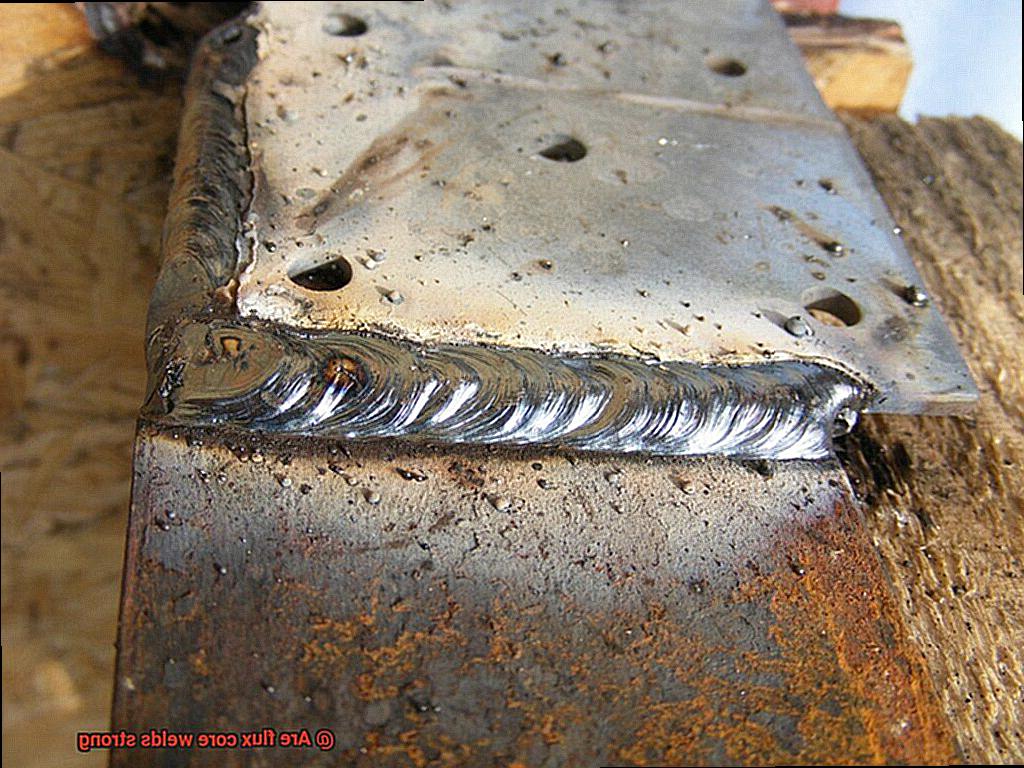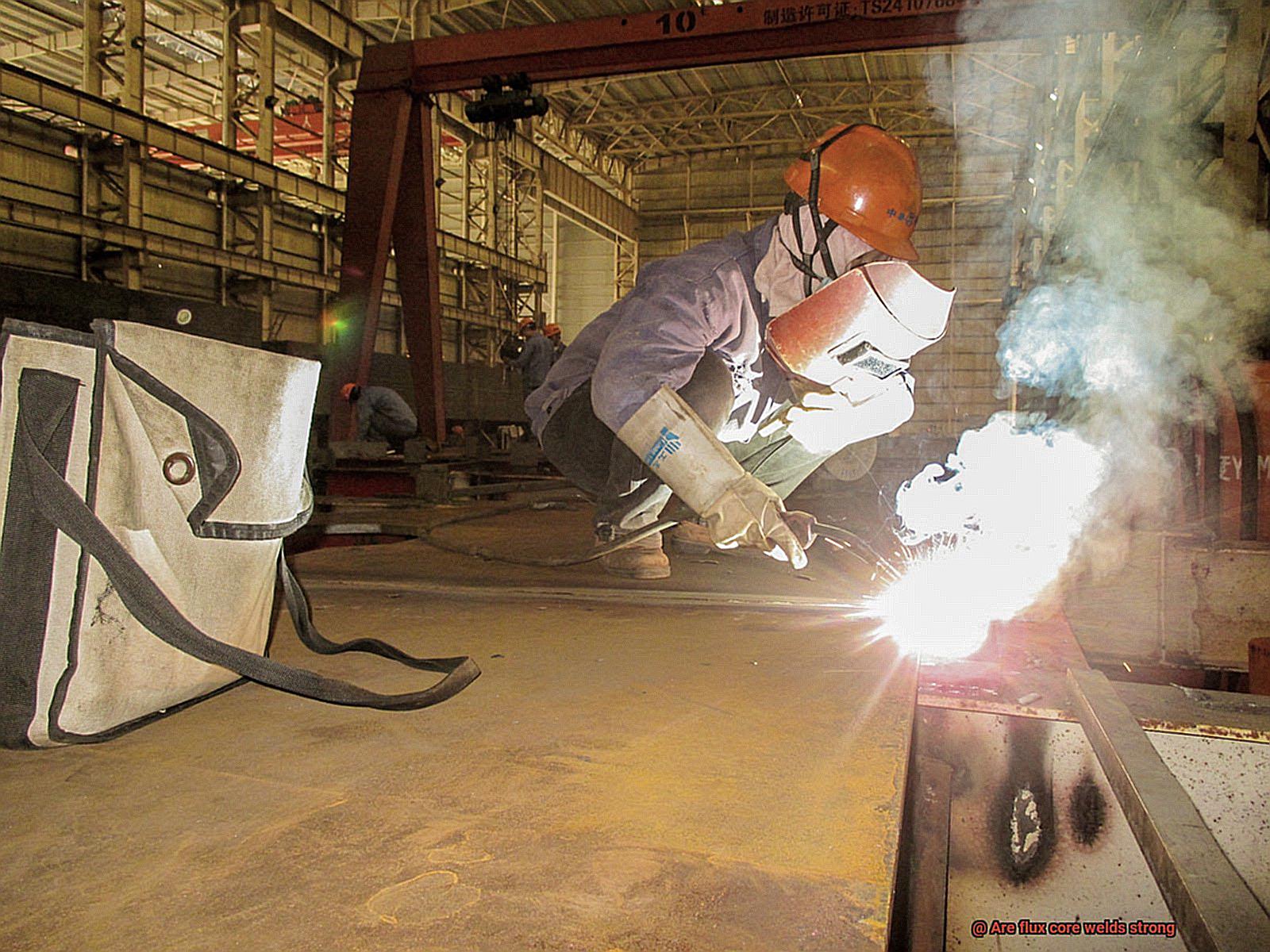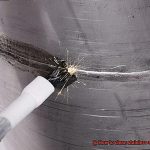Welding is an art that requires a combination of expertise, skill, and finesse to produce a durable and reliable weld.
But choosing the right type of welding is equally important. Flux core welding has been gaining popularity in recent years due to its ability to create strong and efficient welds using a flux-filled wire.
However, if you’re new to welding or even an experienced welder, you may be wondering if flux core welds are strong enough to stand the test of time. That’s why we’re here to answer the million-dollar question: Are flux core welds really strong?
In this blog post, we’ll dive deep into the world of flux core welding and explore its strength compared to other types of welding. Whether you’re looking to learn more about welding techniques or seeking valuable insights as a seasoned welder, this post has got you covered.
We’ll kick things off by defining what flux core welding is and highlighting its differences from other types of welding. Then, we’ll delve into the factors that determine the strength of a flux core weld and provide tips on how to achieve the strongest possible weld.
But that’s not all. We’ll also showcase real-world examples where flux core welding has been used successfully and discuss how it holds up in those situations.
So, let’s begin.
Advantages of Flux Core Welding
Contents
- 1 Advantages of Flux Core Welding
- 2 Disadvantages of Flux Core Welding
- 3 What is Flux Core Welding Used For?
- 4 Are Flux Core Welds Strong?
- 5 Is Flux Core Welding Stronger Than MIG?
- 6 What are the Disadvantages of Flux Core Welding?
- 7 How Much Weight Can Flux Core Weld Hold?
- 8 Is Flux Core Stronger Than TIG?
- 9 Conclusion
This popular welding technique uses a flux-filled wire electrode that melts and fuses with the base material to form a strong bond. But that’s not all – here are some of the top advantages of flux core welding:
Firstly, versatility is one of the significant benefits of flux core welding. It can be used for a wide range of materials, including stainless steel, carbon steel, and aluminum.
This makes it an excellent option for those who need to weld different types of materials for their projects. Secondly, flux core welding is more cost-effective than other welding methods like TIG and MIG.
The cost of flux core wire is lower than that of solid wire, and it requires less equipment. This means you can save money while still producing strong and reliable welds.
Thirdly, flux core welding has a high deposition rate, which means that it can weld thicker materials quickly. It can also produce deeper penetration than other welding methods.
This makes it an excellent choice for heavy-duty applications that require high-strength welds. Fourthly, compared to other welding methods, flux core welding is relatively easy to learn.
It does not require as much skill or experience, making it an excellent option for beginners. With some practice and guidance, anyone can master this welding technique.
Lastly, flux core welding can be used outdoors because the flux in the wire protects the weld from contaminants such as dirt and moisture. This makes it ideal for construction projects or any other work that involves welding outside.
Overall, flux core welding produces strong and durable welds in a versatile and cost-effective manner. Whether you’re a beginner or a professional welder, this technique can help you get the job done quickly and efficiently.
Disadvantages of Flux Core Welding
Flux core welding is a fantastic welding process that can help you create a solid and cost-effective weld.
However, it also has its limitations that must be taken into account before choosing it for a particular project. In this section, we’ll dive deeper into the disadvantages of flux core welding.
One of the most significant drawbacks of flux core welding is the high level of spatter and slag produced during the process. Imagine trying to paint a masterpiece with a brush that splatters paint everywhere – not ideal, right?
The same thing happens with flux core welding – the spatter and slag can be challenging to clean up and can create defects in the weld that weaken it. This can cause damage to nearby equipment and make it challenging to produce high-quality welds.
Another disadvantage of flux core welding is the fumes and smoke produced during the process. The fumes can be harmful to welders if they are not wearing proper protective gear, and the smoke can obscure visibility, making it difficult to see what is happening during the welding process.
It’s like trying to cook in a kitchen filled with smoke – you can’t see what you’re doing. This can compromise your safety and make it harder to achieve the desired results.
Furthermore, flux core welding requires a higher level of skill than other welding processes like MIG welding. It takes time and practice to master the technique and produce consistent, high-quality welds.
Inexperienced welders may struggle with flux core welding and may not be able to produce strong welds. This means that if you’re new to welding or don’t have much experience with flux core welding, it may not be the best option for your project.
Lastly, flux core welding is not suitable for thin materials. The high heat input required for the process can cause warping and distortion in thin sheets of metal, making it difficult to achieve a strong, even weld.
It’s like trying to lift heavy weights with noodle arms – you’re just not going to get far. If you’re working with thin materials, other welding processes like TIG welding may be more appropriate.
Welders must weigh the benefits and drawbacks carefully before deciding whether or not to use flux core welding.
What is Flux Core Welding Used For?
It has incredible versatility and can handle an extensive range of applications, from construction to manufacturing and repair work. One of the most remarkable features of flux core welding is its ability to penetrate through thick metal.
It’s like having the superpower to weld through even the toughest materials, making it an ideal choice for welding heavy-duty metals. This feature makes it an excellent option for building structures like buildings, bridges, and pipelines that require strong and durable welds.
In addition to its strength, flux core welding is incredibly efficient. It can produce high-quality welds in a short amount of time, making it perfect for quick repairs or large-scale projects.
It’s like having the Flash on your team – fast and efficient. If you’re a contractor who needs to move equipment from one location to another, flux core welding is the answer to your prayers.
Its equipment is small and lightweight, making it incredibly portable. It’s like having a superhero who can travel anywhere in the world at lightning speed.
But wait, there’s more. Flux core welding is also cost-effective compared to other types of welding processes.
The cost of equipment and consumables needed for flux core welding is generally lower than TIG or MIG welding. It’s like having a superhero that saves you money while still being strong and fast.
So, flux core welding is the ultimate superhero in the world of welding. Its versatility, strength, efficiency, portability, and cost-effectiveness make it an ideal choice for many industries, including construction, manufacturing, and repair work.
Are Flux Core Welds Strong?
The quality of the welding wire is crucial to the strength of a flux core weld. It’s essential to use high-quality wire that is designed for the specific application you’re working on.
Welding with improper or low-quality wire can result in weak and unreliable welds. Flux core welding is perfect for thick metals because it creates deep penetration welds that are often stronger than other types of welds like MIG or TIG welds.
This technique is ideal for heavy loads and stresses, making it perfect for structural applications. The skill level of the welder also plays a crucial role in producing strong and reliable flux core welds.
Proper training and experience are essential to ensure that high-quality welds are created that can withstand heavy loads and stresses. While flux core welding produces powerful welds, it does have some drawbacks.
For instance, it produces a lot of smoke and fumes during the welding process, so proper safety measures must be taken to protect yourself and others. Finally, when deciding whether to use flux core welding, it’s essential to consider the load that the weld will need to support.
Welds used in structural applications may require higher strength than those used for decorative or artistic purposes. In conclusion, flux core welding is a robust and reliable technique for creating strong welds.
Is Flux Core Welding Stronger Than MIG?
If you’re in search of a welding process that can produce strong and reliable welds, you might wonder whether flux core welding or MIG welding is the better choice.
While both processes have their advantages and disadvantages, let’s explore why many professionals lean towards flux core welding. Flux core welding uses a continuous electrode that produces a shielding gas, which protects the weld from contaminants.
This creates a deep penetration weld that is ideal for heavy loads and stresses in structural applications. Think of it as a superhero that can handle any challenge thrown its way.
On the other hand, MIG welding uses a wire that is fed through a spool, and the weld is protected by an external gas supply. While MIG welding is popular for its ease of use and versatility, it may not be as strong as flux core welding.
However, keep in mind that the strength of a weld depends on various factors. For example, the welding technique, materials being welded, and the skill of the welder can all affect the strength of the final product.
In some cases, MIG welding may produce stronger welds than flux core welding. So, how do you decide which welding process to use?
Consider your project’s specific needs. Factors such as cost, ease of use, and desired outcome should all be taken into account when choosing between flux core welding and MIG welding.
What are the Disadvantages of Flux Core Welding?
Before you decide to use this method, it is crucial to be aware of these limitations.
One significant disadvantage of flux core welding is the high amount of smoke and fumes produced during the process. This can be hazardous for the welder’s health if proper ventilation is not provided.
So, always ensure that you work in a well-ventilated area or use a respirator to protect yourself from harmful fumes. Another drawback of flux core welding is the amount of slag that it produces.
Slag is the residue left behind after welding and can be time-consuming and laborious to remove. You may need to use a chipping hammer or wire brush to remove it, which can be irritating.
Flux core welding also requires specialized equipment and materials, making it more expensive than other types of welding. If you are on a tight budget, you may want to consider other methods that require less specialized equipment to save money.

Moreover, flux core welding is not suitable for thin materials as it tends to produce rougher welds and can even burn through thin metals. It also requires higher amperage than other types of welding, which can cause overheating and distortion in the metal being welded.
Finally, while flux core welding can produce strong welds, it may not be as precise or aesthetically pleasing as other types of welding such as TIG welding. Welders looking for a clean and precise finish may prefer other methods over flux core welding.
Therefore, it’s essential to weigh these factors carefully before choosing this method.
How Much Weight Can Flux Core Weld Hold?
Well, the answer is not a straightforward one.
The strength of a flux core weld depends on several factors, including the size of the weld, the type of flux core wire used, and the welding technique employed. If you’re welding thick steel plates together, you will need to use a thicker flux core wire to ensure that the weld can bear the weight.
Larger welds are generally stronger than smaller ones, but they require more material and time to complete. One of the most significant factors in determining the strength of a flux core weld is the type of flux core wire used.
Different wires have different properties, and choosing the right one for your project can make a big difference in the strength of the final weld. But, it’s not only about weight-bearing capacity.
The quality of the weld is also important in determining its overall strength. Poor-quality welds are more likely to fail under stress or corrosion.
Flux core welding produces a more penetrating weld than MIG welding, resulting in stronger and more durable joints. However, proper technique is crucial to ensure optimal results.
So, a well-executed flux core weld can hold a considerable amount of weight. However, to achieve optimal results, you need to consider all the factors mentioned above and use proper technique and equipment.
Is Flux Core Stronger Than TIG?
The answer is not a simple one.
Each process has its own unique strengths and weaknesses, and the strength of a weld depends on several factors beyond just the welding process. However, in general, flux core welding is known for producing stronger welds than TIG welding.
So, what makes flux core welding so strong?
First off, flux core welding uses a flux-cored wire that contains a shielding agent.
This agent protects the weld from air and other contaminants that can weaken the bond between two pieces being welded. By shielding the weld from external factors, flux core welding creates a stronger and more durable bond.
Another factor that contributes to the strength of flux core welding is its ability to produce deeper penetration than TIG welding. This means that more material is fused together, resulting in a stronger bond between the two pieces being welded.
It’s like building a sandcastle – pouring water directly onto it will create a stronger structure because more sand is fused together. However, it’s important to remember that the strength of a weld ultimately depends on several other factors as well.
The specific materials being joined, the skill of the welder, and the conditions under which the welding takes place all play a role in determining how strong the final product will be. While TIG welding is often preferred for its precision and aesthetic appeal, if you need to create strong and durable welds, flux core welding is often the way to go.
By using a shielding agent and producing deeper penetration, flux core welding creates a bond that can withstand even the toughest conditions.
So, while there isn’t a straightforward answer to whether flux core welding is stronger than TIG welding, in general, flux core welding produces stronger welds due to its use of a shielding agent and ability to produce deeper penetration.
Conclusion
In summary, flux core welding is a top choice for those looking to create strong and long-lasting welds.
Its ability to penetrate through thick metals, cost-effectiveness, and high deposition rate make it an ideal option for heavy-duty applications in construction, manufacturing, and repair work. However, it’s important to note that the process isn’t without its limitations such as the production of spatter and slag during welding.
The strength of a flux core weld depends on several factors including the quality of welding wire used, size of the weld, type of materials being welded together, skill level of the welder, and conditions under which welding takes place. When compared to TIG welding, flux core welding is known for producing stronger welds due to its use of a shielding agent and deeper penetration capability.
With proper training and experience in flux core welding techniques coupled with attention to detail in choosing materials and equipment used during the process can produce optimal results that can withstand even the toughest loads and stresses.





